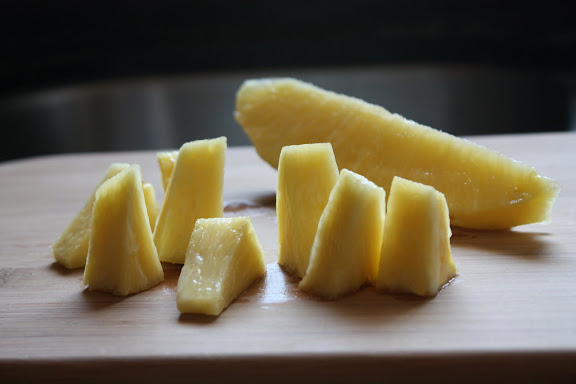
Ask any random older Thais who grew up eating traditional Thai sweets — the types that are wrapped and steamed in banana leaves or served from clay pots — to comment on the state of Thai desserts, and you’ll get an earful. They’ll express to you either outrage (“Thai desserts are more fattening than Western desserts? Bollocks!“) or a combination of scorn and despair (“Kids these days don’t know [insert the name of a traditional Thai dessert] anymore. They just want panna cotta and tiramisu!“). Often, you’ll get both.
This discussion is probably best reserved for a later time in a different post. For now, let me just say one thing. Different desserts may have come and gone, but as long as the weather in Thailand remains as hot and humid as it is, one category of traditional Thai desserts will never ever go out of popularity: fruit loy kaew [1] (ผลไม้ลอยแก้ว).

A loy kaew is essentially a fruit (or a mélange of loy kaew-able fruits) cooked gently in simple syrup and served cold, topped with crushed ice along with the syrup in which it’s cooked. The concentration of the syrup and the length of cooking time vary according to the fruit. Firmer, astringent fruits, such as santol (kra-ton กระท้อน) which is often served loy kaew-ed, would require sweeter syrup and longer cooking time than more delicate fruits like papaya, lychee, or pineapple would.
The syrup is often infused with aromatics, most commonly in the form of fresh tropical flowers such as jasmine. Sometimes, dried spices are used. This pineapple loy kaew which you’re looking at here is inspired by a unique recipe in an old cookbook belonging to my mother; it calls for whole cloves which I’ve found to be a brilliant spice with which to infuse pineapple. But being used to the scent of jasmine in my fruit loy kaew, I felt compelled to also infuse the cooled syrup with fresh jasmine flowers. Luckily, the jasmine scent and the warm aroma of cloves don’t clash at all.
Pineapple in Iced Jasmine-Infused Syrup (สับปะรดลอยแก้ว)
(Serves 6-8)
Printable Version

One large under-ripe pineapple
1 1/2 cup sugar
1 1/2 cup water
1/2 teaspoon salt
4 whole cloves (optional)
About 1/4 cup fresh jasmine flowers or 1 teaspoon jasmine extract
Crushed ice
Peel, core, and cut the pineapple into 1/2 inch pieces.
Place the sugar, water, and cloves in a large pot; bring to a gentle boil.
Add the pineapple pieces to the syrup, bring the mixture to a gentle boil once more, reduce the heat to a low simmer, and allow to cook, uncovered, for 5-8 minutes.
Turn off the heat and let the pineapple cool completely in the syrup. Do not cover the pot.
Once the mixture has cooled completely, fish out the pineapple pieces and set them aside.
Fish out and discard the cloves.
Strain the syrup through a fine-mesh strainer.
Stir the jasmine flowers into the strained syrup and let the mixture infuse at room temperature for about 2-3 hours, then strain out and discard the flowers. If you don’t have jasmine flowers, simply add the jasmine extract to the syrup and you’re done.
To serve, divide the pineapple pieces between 6-8 dessert bowls, add the syrup to each bowl, top with crushed ice. Serve immediately.
[1] The official transliteration for ลอยแก้ว is loi kaeo.















